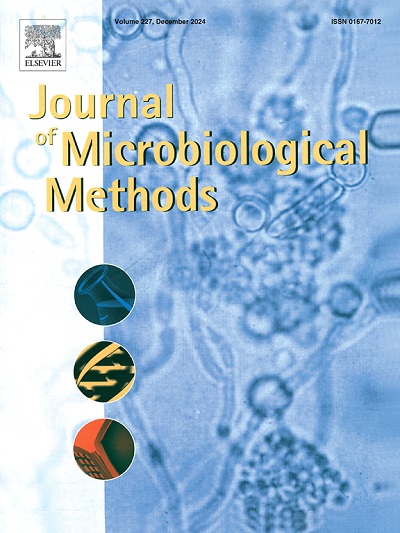人恙虫病东方体(恙虫病)感染分子和免疫学诊断工具的建立
IF 1.9
4区 生物学
Q4 BIOCHEMICAL RESEARCH METHODS
引用次数: 0
摘要
恙虫病是一种由细菌性病原体恙虫病东方体引起的疾病,它通过被感染恙螨叮咬传播。发烧、头痛、身体疼痛和皮疹是恙虫病的常见症状。该病缺乏具体的体征和症状,这使得诊断极其困难。在本研究中,获得感染个体的血液样本,并使用商用ELISA检测试剂盒分析IgM和IgG抗体。目前开展的工作是为了开发一种基于分子和免疫学的技术,该技术对感染者的早期检测更加敏感和准确。用于56 kDa型特异性抗原(TSA)扩增的PCR和巢式PCR等分子诊断方法具有更高的特异性、敏感性和准确性。将PCR扩增的部分56 kDa TSA基因克隆到载体pET27b(+)中,在BL21宿主中表达。重组蛋白经Ni-NTA柱纯化后用于小鼠和家兔制备多克隆抗体。利用该抗体建立ELISA、Western blot、dot blot等免疫学诊断工具,早期检测恙虫病感染。采用本研究开发的PCR、nPCR、ELISA和western blot对141份感染标本进行筛选,并与市售ELISA试剂盒进行比较。在分析的141份样本中,58.8%(83份)的PCR检测呈阳性,73%(103份)的nPCR检测呈阳性,86.5%(122份)的ELISA检测呈阳性。对14例阳性样本进行Western blot分析,阳性结果为100%。新开发的免疫诊断工具和PCR技术显示出高灵敏度和增强的特异性,可以早期发现恙虫病感染。本文章由计算机程序翻译,如有差异,请以英文原文为准。

Development of molecular and immunological based diagnostic tools to detect Orientia tsutsugamushi (scrub typhus) infection in human
Scrub typhus is a disease caused by a bacterial pathogen, Orientia tsutsugamushi which spreads through bites of infected chigger mite. Fever, headache, body aches and rash are common symptoms of scrub typhus. The absence of specific signs and symptoms of the disease makes diagnosis extremely difficult. In the present study, the blood samples from individuals with infections were obtained and analyzed for IgM and IgG antibodies using a commercial ELISA test kit. The present work was carried out to develop a molecular and immunological based technique which are more sensitive and accurate for the early detection of infected persons. The molecular diagnostics like PCR and nested PCR used for amplification of the 56 kDa type specific antigen (TSA) are more specific, sensitive and accurate. The PCR amplified partial 56 kDa TSA gene was cloned into the vector pET27b (+), and expressed in the BL21 host. The recombinant protein was purified by Ni-NTA column, and then the purified protein was used for production of polyclonal antibody in mice and rabbits. The antibody was used to develop immunological based diagnostic tools like ELISA, Western blot and dot blot for the early detection of scrub typhus infection. Totally, 141 infected samples were screened by PCR, nPCR, ELISA and western blot developed in the present study and the results were compared to commercial ELISA kit. Out of 141 samples analyzed, 58.8 % (83 samples) tested positive by PCR, 73 % (103 samples) by nPCR, and 86.5 % (122 samples) by ELISA. Western blot analysis of the 14 selected positive samples showed positive results (100 %). The newly developed immunological diagnostic tools and PCR techniques demonstrated high sensitivity and enhanced specificity, allowing for early detection of scrub typhus infection.
求助全文
通过发布文献求助,成功后即可免费获取论文全文。
去求助
来源期刊

Journal of microbiological methods
生物-生化研究方法
CiteScore
4.30
自引率
4.50%
发文量
151
审稿时长
29 days
期刊介绍:
The Journal of Microbiological Methods publishes scholarly and original articles, notes and review articles. These articles must include novel and/or state-of-the-art methods, or significant improvements to existing methods. Novel and innovative applications of current methods that are validated and useful will also be published. JMM strives for scholarship, innovation and excellence. This demands scientific rigour, the best available methods and technologies, correctly replicated experiments/tests, the inclusion of proper controls, calibrations, and the correct statistical analysis. The presentation of the data must support the interpretation of the method/approach.
All aspects of microbiology are covered, except virology. These include agricultural microbiology, applied and environmental microbiology, bioassays, bioinformatics, biotechnology, biochemical microbiology, clinical microbiology, diagnostics, food monitoring and quality control microbiology, microbial genetics and genomics, geomicrobiology, microbiome methods regardless of habitat, high through-put sequencing methods and analysis, microbial pathogenesis and host responses, metabolomics, metagenomics, metaproteomics, microbial ecology and diversity, microbial physiology, microbial ultra-structure, microscopic and imaging methods, molecular microbiology, mycology, novel mathematical microbiology and modelling, parasitology, plant-microbe interactions, protein markers/profiles, proteomics, pyrosequencing, public health microbiology, radioisotopes applied to microbiology, robotics applied to microbiological methods,rumen microbiology, microbiological methods for space missions and extreme environments, sampling methods and samplers, soil and sediment microbiology, transcriptomics, veterinary microbiology, sero-diagnostics and typing/identification.
 求助内容:
求助内容: 应助结果提醒方式:
应助结果提醒方式:


